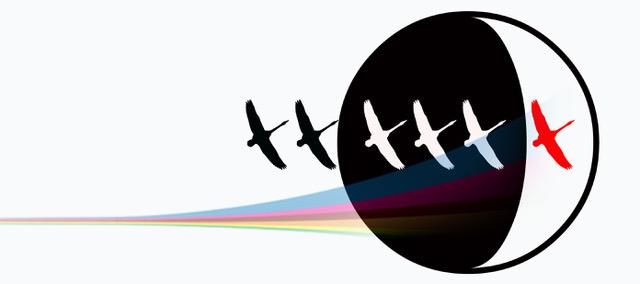Wildlife-Friendly Design
Sustainable Design Department
Creative Solutions to Living with Wildlife Naturally
Wildlife-Friendly Design and Development
ZLI's Wildlife-Friendly Design team seeks to partner with institutions, to encourage biodiversity-loss mitigation strategies in architecture and development globally. As a charity, we pursue a combined planning and fundraising strategy with institutions and private organizations rather than providing a direct professional service as such. We instill wildlife-friendly design as an integral standard practice across the industry, beyond each individual project. Comprehensive planning is therefore our hallmark.
We promote three areas of Master Planning:
-
- Natural Light/ALN Mitigation Master Planning
- Bird-friendly Master Planning
- Wildlife Provisioning Master Planning.
Additionally, ZLI’s Wildlife Friendly Development services include three kinds of facility design partnerships:
-
- Theatrical & Program Design
- Animal Health/Welfare Exhibit Design
- Day-Night Light Facility Design
We are always looking for philanthropic corporations and like-minded partners who want to help us expand our impact through mutually beneficial partnerships. Contact our team today to discuss options on how you can protect wildlife in your community!
Master Planning
Natural Light/ANL, Bird-Friendly & Provisioning
Guidelines & Benefits
General Guidelines & Benefits of Master Planning
ZLI Sustainable Design promotes data-driven risk management in accord with our mission to support the sciences through the arts for wildlife conservation and animal welfare. It provides actionable elements to go along with intellectual and theoretical capital produced by the other ZLI Departments. ZLI Sustainable Design promotes wildlife sensitive planning and facility design, especially related to light and lighting challenges.
Master Planning is a crucial element for any undertaking. This is especially true in the field of photobiology, photo-ecology and the human perception of light, which is always relational. Master Planning has succinctly been summarized by the World Bank:
“A master plan is a dynamic long-term planning document that provides a conceptual layout to guide future growth and development. Master planning is about making the connection between buildings, social settings, and their surrounding environments…”
Master Planning Components
ZLI Sustainable Design encourages Master Planning for Natural Light/ANL, Bird-friendly and Biodiversity Provisioning, consisting of these elements:
- Assess environmental, ecological and biological site resources and limitations.
- Identify and address facility/audience/occupant ‘interest’, desires and behaviors.
- Define occupancy qualities and schedules, as well as public amenities and value.
- Determine the mix of uses, their physical relationship and implications.
- Conceptualize and shape the proposed environment.
- Act as a framework for regeneration and attract private sector investment.
- Engage local communities and act as consensus builder.
- Develop a phasing and implementation schedule to identify priorities for action.
Components
Commitment
Master Planning Requires Commitment
Master Planning is necessary, but it not something to enter into lightly. Too often for example, institutions painstakingly and expensively adopt an architectural master plan, only to subsequently ignore or abandon it. Often times, plans are indeed impractical and represent a ‘vision’ rather than a set of strategies under guiding principles. Too often, finance nor operations are included in the planning of such documents, with the pretense that the funding will come some unspecified time in the future through, as of yet, unknown sources. Lack of planning and lack of fidelity to mission are a mistake.
Master Planning requires commitment, from both in-house and external consultants. An initial Master Plan might take one or two years to complete properly, during which time dialogue ought to be on-going to account for current work. Commitment is required to produce a Plan but also to carry it out. A dedicated internal person or team should be established to coordinate the process, and external consultants should be kept on in a ‘Commissioning’ Phase to help retain institutional memory and intent. This Commissioning might be no more than a meeting or two a year, but it is important to do so for an extended and agreed to period. In this way, a Master Plan remains a living and relevant document and its purposes achieved.
The terms of planning also need to be such that the proposed solutions improve the institution’s business model according to its agreed mission (for a zoo or aquarium, this ought always to be recreation provision (community bonding) in support of research, animal welfare and wildlife conservation, though emphasis might be greater on one element or another). Good finance breeds continuity, and continuity breeds success.
Master Plans are also inter-related, and inter-relationships help to make undertakings more effective. With that in mind, there are three fundamental types of Master Plans the ZLI Sustainability Department suggests and seeks to partner with institutions on.
Kinds of Master Plans

Natural DayLighting / ALN Mitigation Master Plans
As a charitable organization dedicated to the sciences of light and life, ZLI conceptualizes light a bit differently from other architectural lighting approaches. Although it is more common to think of night as ‘dark’ and day as ‘light’, reading light scientifically entails changing the common way of thinking. Natural light serves as a baseline, whether starlight or high noon. Artificial light supplements natural light, altering this baseline rather than serving as a norm itself. This is a big step, but once it is taken, the purchase, use and maintenance of artificial lighting can be undertaken with much greater care and with more powerful and productive results.
Placing natural light first brings added benefits too. It fosters more impactful aesthetic experiences, sequentially coordinating vision holistically with environmental conditions. It reduces unintended impacts on ecological resources, thereby lowering risks and increasing value.
A natural light first approach also takes into account the timing of activities, thus improving efficiencies and finding underutilized opportunities. Health impacts of artificial light can be more carefully managed and, theatrical effects more strictly controlled to produce a better show. Each of these arenas supports an overall mission of wildlife conservation, animal welfare and sustainable ecological design. ZLI can help an institution find a designer and ensure that fidelity to mission is maintained.
Schedule a Free Consultation
Bird-friendly Design Master Plans
Glass exposed to the environment is a terrible threat to birds. Over one in ten adult breeding birds are thought to die annually in collisions. This number adds up quickly; well over a billion birds die annually in the United States alone solely due to architectural glass. When combined with the take due to habitat degradation caused by light pollution, these events are catastrophic for birds and so, for all of us.
Many cities across the globe have enacted bird friendly regulations to support fixing this problem, but fail to see the aesthetic and sustainable positives that the alternatives to naked, exposed glass offer. Because of this, mitigation tends to be reactionary, staid and piecemeal rather than proactive, creative or holistic. A Bird-friendly Design Master Plan of the latter kind becomes a valid asset for those that pursue it.
Workable alternatives to exposed bird-killing glass are many. They fall into three categories: markings, screenings/lattice (layered facades) and translucent (rather than transparent) materials. Each offers a creative opportunity for engaging architectural expression, possibly including marketing, public education/outreach or mission oriented resources.
A comprehensive bird-friendly design master plan seeks not only to remedy an immediate problem (collisions), but also seeks to advance new funding streams such as ecotourism, corporate sponsorship, heritage marketing as well as by encouraging entertainment and educational programming. ZLI promotes planning in this field that includes funding and outreach, so that communities are inspired to follow a leader in protecting birds.
Schedule a Free Consultation
Wildlife Provisioning Master Plans
Humankind and wildlife are always inseparably linked to each other. This is an enormous benefit to a zoo and its community/administration, because it serves to closely connect people to the institution despite the seeming exotic nature of the animals. A Wildlife Provisioning Masterplan examines the ways in which wild, local and migratory species interact with the zoo grounds, and ways in which this interaction might be improved or put to good use.
Elements of a Wildlife Provisioning Master Plan include attention to habitat connectivity, food or water resources, nesting and breeding grounds. But it also includes an assessment of the potential outreach to local and foreign visitors. A Wildlife Provisioning Master Plan thus connects into an overall Master Plan, both Organizational and Architectural. As with the Natural Light/ALN Master Plan, the Wildlife Provisioning Master Plan explores its topics over time, in seasonal, monthly, daily and hourly increments. This recognizes not only natural patterns, but also important public calendars and holidays for targeted outreach. Wildlife and animals matter to community, and community matters to healthy wildlife populations and animals in our care.
Schedule a Free ConsultationFacility Design Review
for Wildlife Conservation and Welfare
ZLI Sustainable Design supports three arenas of facility design: theatrical lighting, animal health and welfare, welfare and natural light (inc. daylighting and ALN (artificial light at night) mitigation).
Facility design support enacts not only ZLI’s Mission, by providing real-world examples of the value of science, but those of our partners. We encourage the development and application of photobiology research, fostering greater understanding of the relationships of light and life. This in turn enhances the quality, productivity and viability of community life .
ZLI Wildlife Sensitive Facility Design emphasizes a diversity, engagement and inclusion ethic, drawing upon traditional design elements as well as modern. This is true for the way we help an institution to build a project teams, the way we develop a portfolio of partners and the way in which we view the value of design to celebrate science productively. We want projects to be joyous and playful, but how this it is accomplished matters. We take very seriously the challenges of biodiversity-loss, animal welfare and what proper solutions mean for diverse communities around the globe. We face head-on the primary institutional challenge of sharing pressing concerns, because it is in the ultimate benefit of communities that we do so.
ZLI Sustainable Design emphasizes lighting control, whether passive or technological, as a fundamental priority in pursuit of data-driven design strategies and appropriate photo-biological metrics. Such an approach is unique to ZLI, but directly in accord with future sustainable best practices that recognize wildlife as a priority. Basing our work in the sciences, and insisting upon data-driven metrics, justifies the boldness of this statement.
Light is fundamental to life, and an integral aspect of animal (including human) health and well-being.

Theatrical Exhibit Design
Aquarium, zoo and museum live and theatrical presentations provide a necessary service to the public, by creating, fostering and engendering emotional and intellectual connections with animals. Animal welfare in this context is a paramount concern, but so too is show impact. This means controlling the distribution and timing of light carefully, in accord with refined story-telling, rich narrative support and a willingness to understand animal photobiology and to act upon it. Partnership with ZLI aids a designer and client/owner to find meaningful connections that build lasting communities. ZLI’s Theatrical Exhibit Design can aid in finding professionals for theming, scripting, lighting, set design and commissioning services.
Schedule a Free Consultation
Animal Health and Welfare Exhibit Design
All animals evolved within the regular cycles of natural light, whether within the depths of the ocean or on the peaks of the Himalayas. Biology and behavior are inextricably tied to environment, and although life displays a certain resilience, the maintenance of an environment as close to an indigenous one as possible is not only an obligation, but an opportunity to advance science and strengthen community by improving animal health and welfare. ZLI’s Animal Health and Welfare Exhibit Design underscores relationships of habitat to life, with the aim of improving animal welfare and of connecting the public to animals, on their own terms. ZLI’s Animal Health and Welfare Exhibit Design also addressed threats to wild animal populations, stressing integrated pest management, bird-friendly design and balanced provisioning.
Schedule a Free Consultation
Daylighting / Night Lighting Facility Design
.Daylighting is a familiar architectural service, emphasizing the optimization of natural light within a building, to save energy, to improve performance and to encourage thoughtful and marketable creativity. It is an essential component of responsible and sustainable design. ZLI Daylighting / Night-lighting takes this basic service one step further, recognizing that natural light at night is also a vital component of healthy and productive environments. Just as poorly designed architecture mishandles natural sun and sky light, requiring added and deleterious artificial lighting, poorly and overly supplied artificial lighting restricts access to moon and starlight at night. Human health, animal health, ecological health and energy performance are each in turn harmed. ZLI Day/Night Lighting Facility Design reinvents traditional best practices in architecture, to help aquariums, zoos and museums operate more efficiently and in accord with their missions.
Schedule a Free ConsultationFinancial Support and Arrangements
Partnerships with ZLI proceed on a Membership basis, with annual Memberships starting at $100,000.00. This ‘retainer’ allows ZLI to commit resources for client fundraising, professional acquisition and to guide clients through the eight (8) steps of the planning or design process. An additional percentage of the resulting procured fundraising (depending on project complexity and scope) is additionally allocated to The Zoological Lighting Institute and its scholarship programs, comprising a charitable donation to the Mission of ‘Supporting the Sciences of Light and Life through the Arts for Animal Welfare and Wildlife Conservation’. Please schedule an initial meeting to discuss your project with Dr. Fischer directly here.
Join the Movement
We welcome you to become part of our global community of volunteers, partners, sponsors, and other supporters. Together, we can shape the future today!

Become a Member
Become part of our global community of like-minded individuals and organizations to help advance science for wildlife!
Join Now
Become a Partner
We are always looking for like-minded partners who want to work together to double our impact.
Join Now
Become a Sponsor
We are always looking for philanthropic corporations and other sponsors who want to help us expand our impact through mutually beneficial partnerships.
Join Now


